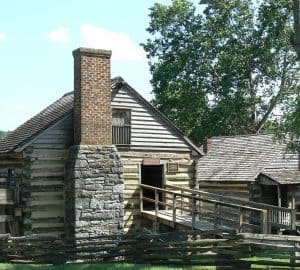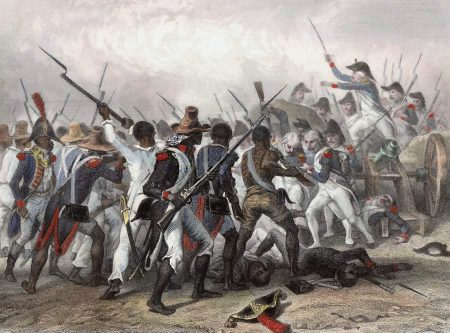
We are pleased to welcome Chris Galbicsek of Exoteric Apparel with this post on the Haitian Revolution – The Editor
Americans are well aware that the struggle over slavery greatly impacted the nation, when it nearly tore the country in half during the Civil War. But far fewer Americans realize that seventy years earlier, there was another important episode in the struggle against slavery, which also fundamentally reshaped the nation. It was the most successful slave revolt in history, occurring just off the coast of Florida. The result was not only the independent nation of Haiti, but also a United States which was more than doubled in size.
Way back when Columbus landed in the New World in 1492, the first permanent settlement he established was on an island the explorers dubbed “Hispaniola”. Fast forward three centuries, and the French slave colony of Saint-Domingue sat on the western end of that very same island.
Saint-Domingue was home to approximately half a million enslaved Africans, who vastly outnumbered the thirty thousand white colonists. (Notably, there were also around twenty five thousand free-people of color in the colony, who themselves owned around one third of the plantations, and about one quarter of the slaves.) The colony had become one of the most profitable holdings in the French kingdom, exporting prodigious amounts of sugar,
But despite the considerable profits from Saint-Domingue, the French kingdom as a whole was dangerously in debt in the 1780’s. King Louis had made various attempts to rectify the financial situation, but had been unsuccessful. Finally in desperation, the king reluctantly reached out to the people of France directly. It turned out to be a fateful decision, however, as public calls for reform were far more intense than the king had expected. The representatives of the people were unwilling to be mollified easily, and when the situation quickly became too unwieldy for the indecisive king to handle, the political watershed known as the French Revolution burst wide open.
Soon, wave after wave of egalitarian idealism began to roll in, channeled through and a newly established legislative body known as the National Assembly. They set to work deconstructing the systems of class privilege, which had long been legally embedded in French culture.
The language of equality quickly permeated the air in France, and before long these ideas migrated across the ocean to the island of Saint-Domingue. Rumors of freedom began to circulate in the colony, and optimism entered the hearts and minds of slaves.
In France, the revolutionary National Assembly broke ground when they codified “The Declaration of Rights of Man” in 1789. Indeed, the French revolutionaries had consulted none other than Thomas Jefferson himself in drafting the document. Though not explicitly stated, it had seemed as though this initial legislative action had committed the movement to the abolition of slavery. But when push came to shove, the legislative body balked on its own idealism. In a moment of egregious hypocrisy, despite the voices of some committed abolitionists, the assembly members voted that the universal rights ought not apply to the French colonies, in light of their economic importance.
But throughout the French Revolution, when the legislative process became stymied at the top, agitation on the ground level would often come along to break the political logjam.
On August 22 1791, around 10 o’clock at night, an example of just this sort of ground level agitation occurred.
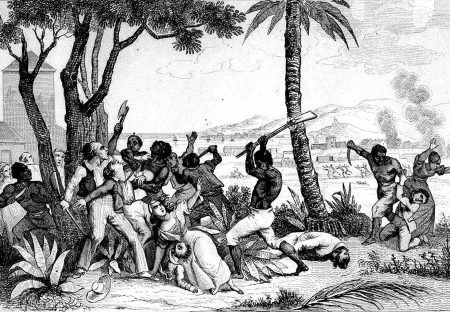
Revolt
Slaves met under cover of darkness at a predetermined location in northern Saint-Domingue. Armed only with machetes and fire, bands of slaves went from plantation to plantation, setting fields of sugarcane aflame, wreaking havoc on the homes of plantation holders, killing whites, and smashing sugar mills. Their numbers grew, and by two weeks later, slaves had risen up in 23 of the 27 parishes of the northern province. By the end of September, the insurgent army had grown to at least 20,000. Insufficiently armed as they were, the army of slaves tended to avoid pitched battles, favoring guerilla style tactics and retreating into the mountains when necessary.
Back in France
News of the rebellion did not hit Paris until two months later, in October 1791, at a time when a whirlwind of political activity was occurring on the home front. An entirely new class of Revolutionary legislators had just been ushered in, and this new National Assembly was already contemplating war with Austria. Moreover, in the span of the next eighteen months alone, the French monarchy was abruptly dismantled, a new republic would be erected in its place, a near fatal invasion by the Prussian army would barely be stemmed, the king was put to death, and to top it off, France declared war with nearly all of the powers in Europe. This incredible litany of events occurred alongside the developments in Saint-Domingue.
The French Response
Nevertheless, in the summer of 1792, France sent three commissioners to put down the rebellion and to restore order in the colony. One of these commissioners was a twenty-nine year old Léger-Félicité Sonthonax, who had been known to have abolitionist leanings. Santhonax was assigned to northern Saint-Domingue, and he would prove to be exceptionally influential over the next few years, deftly threading the needle through a difficult and volatile situation.
Compounding the difficulty of his assignment, the Spanish and British both inserted themselves militarily on Saint-Domingue. Santhonax responded cleverly, by unilaterally offering the promise of liberation to black rebels, in a desperate attempt to win them back to the French side. The gambit was effective. Amazingly, by February 1794, Sonthonax had not only persuaded Paris that his actions had been necessary, but the legislature in Paris went even further, officially abolishing slavery altogether, and extending full citizenship to blacks throughout all French territories.
Perhaps for this reason, the brilliant commander of the former slaves named Toussaint L’Ouverture broke with the Spanish and joined with Santhonax in May of 1794. It caused a tipping point in the conflict. While warfare continued to rage on for several more years, L’Ouverture eventually emerged as the dominant force in Saint-Domingue by 1800.
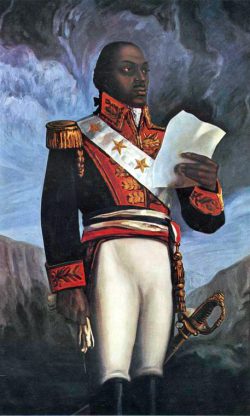
Toussaint L’Ouverture
Toussaint L’Ouverture was an intriguing and complex historical character, who forces us to grapple with the nuances of historical reality. In his life before the revolt, he is believed to have been both a former slave and also a slave-owner. Upon masterfully achieving victory in Saint-Domingue, he did not attempt to break away from France, and made it clear that he still considered himself a loyal Frenchman, while at the same time he boldly spearheaded a separate Constitution for Saint-Domingue without French approval. Finally, as L’Ouverture began the difficult work of rebuilding the shattered economy in Saint-Domingue, he instituted a new system of labor that pledged to compensate workers for their efforts, but also forcibly prohibited workers from leaving their posts.
But just when it seemed that the people of Saint-Domingue had finally gotten a moment to catch their breath, and a moment to contemplate a new beginning, their short-lived respite was rudely interrupted.
Napoleon
Napoleon Bonaparte took the reigns of the French Revolution in the year 1799. Unlike the French Revolutionaries which had preceded him, Napoleon was guided less by idealism, and more out of an imperialistic practicality. Bonaparte had a clear ambition for vast empire, and this included an expanded French presence in the New World. Two key aspects of his vision in the New World included the Louisiana Territory and the sugar colony of Saint-Domingue.
The Louisiana Territory
The Louisiana Territory referred to a vast swath of uncharted territory on the western border of the young United States. Far larger than the territory comprising the modern state of Louisiana, it not only included New Orleans, but also stretched west from the Mississippi River, all the way across the Great Plains to the Rocky Mountains.
The territory had been in Spanish hands since the end of the Seven Years War in 1763, and the Spanish had made relatively cooperative neighbors for the young United States. For Americans living west of the Appalachians, access to the shipping port at New Orleans had been critical for their livelihoods.
To Napoleon, the Louisiana Territory was attractive both as a way of challenging the British on the world stage, and also as a way of providing supplies to the island of Saint-Domingue. In 1800, Napoleon began setting his plans in motion, when France negotiated the acquisition of the Louisiana Territory from Spain, in exchange for territory in Italy. Thomas Jefferson, who became U.S. President in 1801, was greatly concerned, upon learning of Napoleon’s plans to acquire the Louisiana Territory.
Next, Napoleon sent 20,000 troops across the ocean to subdue Saint-Domingue by force, despite the fact that Toussaint L’Ouverture had not explicitly broken ties with France.
Napoleon had no ideological commitment against slavery, and this became clearer during the course of the military campaign in Saint-Domingue. In May 1802, Napoleon repealed the 1794 law that universally abolished slavery, and reopened the slave trade. This news confirmed what the black forces had suspected, and served to intensify the level of resistance against the French forces.
Over the course of two years, a brutal war of attrition ensued. Casualties racked up on both sides, not just by way of battle, but also by way of disease. The French soldiers suffered a particularly intense outbreak of Yellow Fever, which took nearly one in every three Frenchmen. The black forces suffered even more numerous losses of their own. Toussaint L’Ouverture had been lured into laying down his arms, only to be sent back to France, where he would die in prison.
Nevertheless, the black forces hung on and withstood the French army by employing guerilla tactics and retreating away into the hills. Near the end of 1803, the decimated French forces finally sailed away in defeat, after suffering over 40,000 casualties. Meanwhile, the black forces had endured perhaps twice as many deaths, but in the end managed to outlast Napoleon’s forces.
On Jan 1st 1804, General Dessaline led a ceremony to declare independence. The colony was renamed “Haiti”, a Taíno Indian name for the island before Columbus. The political leaders established a dictatorship and a militarized state with problems of its own, but slavery did not return again. Haiti would be the first independent state in Latin America, and would serve as inspiration to the abolitionist movement in the years that followed.
After the French defeat in Saint-Domingue, Napoleon’s calculus in the New World abruptly changed. Without the linchpin prosperity of Saint-Domingue, the French suddenly had less need for the port of New Orleans. Likewise, defending the rest of the Louisiana Territory suddenly seemed like more of a burden than an asset, and as France once again neared renewed conflict with Britain, Napoleon instead determined that his resources would be better spent elsewhere.
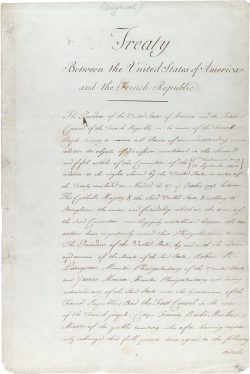
President Thomas Jefferson had no inkling that conditions were so dramatically breaking in his favor. Attempting to salvage an imperfect situation, Jefferson directed American diplomats to make an offer of $10 million for New Orleans and Florida. Much to their everlasting amazement, the French minister Talleyrand offered the Americans the entirety of the Louisiana Territory for next to nothing. As a result, the United States added over 800,000 square miles of land with the single stroke of a pen, and was elevated to an empire virtually overnight.
Today, the United States and Haiti sit on opposite extremes of economic spectrum. Many Americans know Haiti as little more than that perpetually impoverished island nation so desperately in need of aid. Rarely do we learn of any meaningful connection between the two nations. And yet, if not for those brave slaves who gathered under cover of darkness on August 22nd of 1791, where exactly would the United States be now? One wonders how differently it all might have turned out.
About the Author
Chris Galbicsek is the founder of Exoteric Apparel, a historically themed t-shirt brand which infuses fashion with human historical context. Chris studied Philosophy at Colgate University, and came to intensely value history in the years that followed.
Bibliography
Desan, Suzanne M. University of Wisconsin-Madison. Living the French Revolution and the Age of Napoleon. The Great Courses, 2013.
Eakin, Marshall C. Vanderbilt University. Conquest of the Americas. The Great Courses, 2000.




